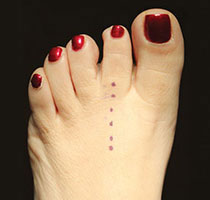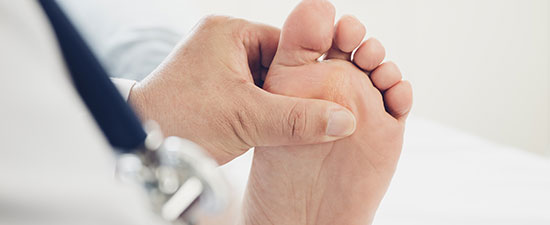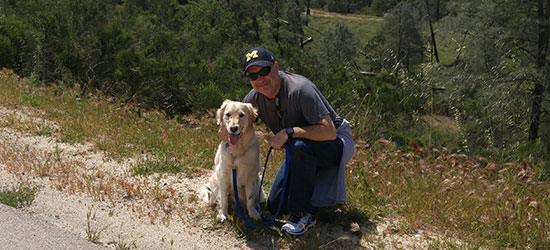- Home
- Foot & Ankle Conditions
- Plantar Plate Injuries
Plantar Plate Injury: causes, symptoms and treatments
- Published 10/8/2018
- Last Reviewed 12/27/2023
What's the plantar plate?
The plantar plate is a strong ligament on the bottom of the foot. It’s a fibrous structure that connects the base of your toe (proximal phalanx) to the forefoot bone (metatarsal head). The plantar plate runs through the joint capsule within the forefoot. Each of your toes, from the big toe to the pinky, has a plantar plate.
Plantar plates keep the toes in place and stop them from over-extending or drifting. As a stabilizer for the metatarsophalangeal joints, plantar plates act as an attachment site for the plantar fascia and your other ligaments and tendons.
A plantar plate tear or injury (sometimes called pre-dislocation syndrome) may be more common than you realize, and you may have even suffered one. Because a common symptom of a plantar plate injury is the second or third toe crossing over its neighbor, these injuries are also called “crossover toe deformities.”
- What causes plantar plate tears?
- What are the symptoms of a plantar plate injury?
- Diagnosing a plantar plate tear
- Conservative treatments for plantar plate injuries
- Plantar plate repair surgical intervention techniques
- Which is better, Arthrex CPR or the HAT-TRICK procedure?
- What is plantar plate surgery recovery time?
- How to prevent plantar plate tears
- UFAI has the most advanced procedures to treat your plantar plate injury
- Frequently Asked Questions about Plantar Plate Tears and Plantar Plate Surgery
- Can a plantar plate tear heal on its own?
- What is the success rate for Plantar Plate repair surgery?
- Can you recommend some good shoes for plantar plate injuries?
-
ABFAS® Board Certified in Foot Surgery and Reconstructive Rearfoot and Ankle Surgery. and Director of University Foot and Ankle Institute
Dr. Bob Baravarian DPM, FACFAS is a Board-Certified Podiatric Foot and Ankle Specialist. He is an assistant clinical professor at the UCLA School of Medicine and serves as Director of University Foot and Ankle Institute.
Dr. Baravarian has been involved in athletics his entire life and played competitive tennis in high school and college. He has an interest in sports medicine, arthritis therapy, and trauma/reconstructive surgery of the foot and ankle. He is also fluent in five languages (English, French, Spanish, Farsi, and Hebrew),
-
ABFAS® Board Certified in Foot Surgery and Reconstructive Rearfoot and Ankle Surgery. and Director of University Foot and Ankle Institute
Dr. Bob Baravarian DPM, FACFAS is a Board-Certified Podiatric Foot and Ankle Specialist. He is an assistant clinical professor at the UCLA School of Medicine and serves as Director of University Foot and Ankle Institute.
Dr. Baravarian has been involved in athletics his entire life and played competitive tennis in high school and college. He has an interest in sports medicine, arthritis therapy, and trauma/reconstructive surgery of the foot and ankle. He is also fluent in five languages (English, French, Spanish, Farsi, and Hebrew),
Learn More from our Plantar Plate Blog Articles
 I suffered a lot of pain from an infected ingrown toenail for 2 months before I qualified for Medicare. Dr Briskin is a God sen...Shirlee K.
I suffered a lot of pain from an infected ingrown toenail for 2 months before I qualified for Medicare. Dr Briskin is a God sen...Shirlee K. The entire staff and Dr. Franson are exceptional. Everyone is professional, courteous, and provide excellent care. Great office...Violet R.
The entire staff and Dr. Franson are exceptional. Everyone is professional, courteous, and provide excellent care. Great office...Violet R. Please provide handicap parkingBarry S.
Please provide handicap parkingBarry S. I have lived with extreme pain in my left ankle for 25 years due to a compound fracture of my left ankle which killed the cartl...Pat G.
I have lived with extreme pain in my left ankle for 25 years due to a compound fracture of my left ankle which killed the cartl...Pat G. Dr. Ambibola Johnson is awesome!Laurie S.
Dr. Ambibola Johnson is awesome!Laurie S. I appreciate the care and timeliness of all my appointments I’ve had at UFAI. Gray, Lydia and the staff all are wonderful. Lydi...Edelmira G.
I appreciate the care and timeliness of all my appointments I’ve had at UFAI. Gray, Lydia and the staff all are wonderful. Lydi...Edelmira G. Very greatfull for the doctor and stuffJesus M.
Very greatfull for the doctor and stuffJesus M. Doctor was very caringBrigitte S.
Doctor was very caringBrigitte S. Everyone is very nice and efficient-
Everyone is very nice and efficient-
Especially Dr Kelman. He takes very good care of me!!Claudia K. Great costumer service.
Great costumer service.
Prompt and efficientDean W. No . I’m pleased with the care .Michael P.
No . I’m pleased with the care .Michael P. Appreciate the professionalism and expertise, as well as the caring.Stella G.
Appreciate the professionalism and expertise, as well as the caring.Stella G.




